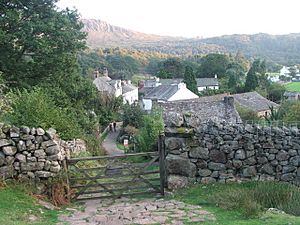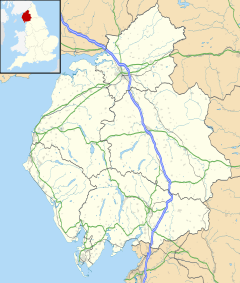Boot, Cumbria facts for kids
Quick facts for kids Boot |
|
|---|---|
| Village | |
 Boot |
|
| Population | 15 |
| OS grid reference | NY1700 |
| Civil parish |
|
| Unitary authority |
|
| Ceremonial county | |
| Region | |
| Country | England |
| Sovereign state | United Kingdom |
| Post town | HOLMROOK |
| Postcode district | CA19 |
| Dialling code | 019467 |
| Police | Cumbria |
| Fire | Cumbria |
| Ambulance | North West |
| EU Parliament | North West England |
| UK Parliament |
|
Boot is a very small village located in Eskdale. This area is on the western side of the famous English Lake District in England. The village is part of the Eskdale civil parish. It also falls within the Cumberland area and the ceremonial county of Cumbria.
The main part of Boot village sits next to a stream called the Whillan Beck. A little further south, about 0.6 miles away, you'll find St Catherine's Church. This church is located by the River Esk. The Whillan Beck flows into the River Esk just after it passes the village.
Discovering Boot Village
Getting to Boot
You can reach Boot village by two main roads. One road comes up the valley from the coast. The other road is a bit more adventurous! It crosses over the Hardknott and Wrynose passes. These passes connect Boot to the central part of the Lake District. The road over Hardknott Pass is known as England's steepest road. Because of this, it often closes during winter or when there is ice.
A fun way to get close to Boot is by taking the Ravenglass and Eskdale Railway. This is a narrow-gauge steam railway that runs during certain seasons. Its last stop is at Dalegarth station. From there, it's only about a 5-minute walk to the village.
A Peek into Boot's Past
Boot and its surroundings have a long history. About 1 mile north of the village, on the moorland, you can find five Bronze Age stone circles. These ancient circles are known as the Burnmoor stone circles. They were built around 2000 BCE, which is a very long time ago!
Even older remains are found about 3 miles to the east. These are the ruins of the Hardknott Roman Fort. Roman soldiers lived in this fort for most of the time between the early 2nd and late 4th centuries. It's amazing to think about the people who lived here so long ago.
In the village itself, there's a historic water mill called Eskdale Corn Mill. This mill dates all the way back to 1547. Since the 1970s, it has been open to visitors. You can see the original milling machines that are powered by two large waterwheels. The mill was updated in 2019 with a big refurbishment. This project cost £1 million and was supported by the National Lottery Heritage Fund.
During the 1800s, people mined for hematite iron ore around Boot. There were mines at Nab Gill, Ban Garth, and Gill Force. These mines were the reason the railway was first built. The railway used to end in the village and had special branches or inclines to connect to the mines. However, the mines didn't produce as much ore as hoped. All of them closed by 1912. Today, you can still see some signs of the old mines and railways.
Life in Boot Today
The number of people who live in Boot all year round is quite small, usually between 10 and 15. But in the summer, the village gets much busier! The population can grow to between 90 and 120 people. This is because the local pubs, bed-and-breakfasts, and holiday cottages fill up with visitors.
Boot has two pubs: The Boot Inn (which used to be called The Burnmoor Inn) and The Brook House Inn. A short walk closer to Hardknott Pass is The Woolpack Inn - Hardknott Bar & Cafe. The Woolpack Inn even has its own brewery called Hardknott Brewery. All these businesses rely on visitors. These include people who love walking in the fells (ramblers), passengers from the railway, and holiday-makers staying at nearby campsites and cottages.


